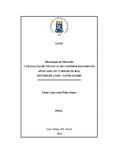| dc.creator | Nunes, Giane Aparecida Polga | |
| dc.date.accessioned | 2017-01-26 | |
| dc.date.available | 2017-01-26 | |
| dc.date.issued | 2004-03-04 | |
| dc.identifier.citation | NUNES, Giane Aparecida Polga. Use of techniques of geoprocessamento
applied to the rural tourism i study of case - Santiago/RS. 2004. 99 f. Dissertação (Mestrado em Geociências) - Universidade Federal de Santa Maria, Santa Maria, 2004. | por |
| dc.identifier.uri | http://repositorio.ufsm.br/handle/1/9538 | |
| dc.description.abstract | The tourism is one of the great activities that they collaborate with the world development, growing in a compared way the sections as informatization and telecommunications and it is one of the activities that more employments and profits generate in the world.
Studies accomplished on the municipal district of Santiago and area, involving historical, cultural, educational, tourist and social aspects, they verified the possibility to create routes, trails and kindred stops that the characteristics and potentialities of the municipal district were disclosed and at the same time it rescued its history. Knowing that the rural tourism is an activity in growth in the whole world and source of generation of income, the City halls of the municipal districts of
Santiago, São Miguel das Missões, Capão do Cipó e Bossoroca are developing the Project Tourist " Roads of Santiago from Brazil " and the present work seeks to develop a methodology using the geoprocessing techniques - SIG and GPS, applied to the rural tourism, to elaborate a rural tourist route prioritizing the historical colonization of the involved municipal districts as well as the valorization of the natural way, where he/she/it looks for to approach the tourist of the contact with the nature. The application of these geoprocessing
techniques, Systems and Geographical Information and System of Global Positioning, as support tools in the elaboration of the tourist route demonstrated to be a necessary and effective tool, because it represents gain of time and economy for the implantation of the
project. The pilgrim, making use of a GPS, it will travel the road, using the maps here developed and he will have in hands the whole necessary tool for its orientation. The application of these geoprocessing techniques is recommended in works that demand a speed and precision of data, facilitating the taking of decisions, as well
as aiding in the implantation of new projects. | eng |
| dc.format | application/pdf | por |
| dc.language | por | por |
| dc.publisher | Universidade Federal de Santa Maria | por |
| dc.rights | Acesso Aberto | por |
| dc.subject | Geoprocessamento | por |
| dc.subject | Turismo | por |
| dc.subject | Sistema de informações geográficas (SIG) | por |
| dc.subject | Sistemas de posicionamento global (GPS) | por |
| dc.subject | Caminhos de santiago | por |
| dc.subject | Roteiro turístico | por |
| dc.title | Utilização de técnicas de geoprocessamento aplicado ao turismo rural - estudo de caso - Santiago/RS | por |
| dc.title.alternative | Use of techniques of geoprocessamento
applied to the rural tourism i study of case - Santiago/RS | eng |
| dc.type | Dissertação | por |
| dc.description.resumo | O turismo é uma das grandes atividades que colaboram com o
desenvolvimento mundial, crescendo de forma equiparada a setores como informatização e telecomunicações sendo que é uma das atividades que mais empregos e lucros gera no mundo. Estudos realizados sobre o município de Santiago e região, envolvendo aspectos históricos, culturais, educacionais, turísticos e sociais, verificaram a possibilidade de se criar roteiros, trilhas e paradas afim de que as características e potencialidades do município fossem
divulgadas e ao mesmo tempo resgatasse a sua história. Sabendo que o turismo rural é uma atividade em crescimento no mundo todo e fonte de geração de renda, as Prefeituras dos municípios de Santiago, São Miguel das Missões, Capão do Cipó e Bossoroca estão desenvolvendo o Projeto Turístico Caminhos de Santiago do Brasil . O presente
trabalho possui como objetivo desenvolver uma metodologia
utilizando as técnicas de geoprocessamento - SIG e GPS, aplicados ao turismo rural, para elaborar um roteiro turístico rural priorizando a colonização histórica dos municípios envolvidos, bem como a valorização do meio natural, onde se busca aproximar o turista do contato com a natureza. A aplicação destas técnicas de geoprocessamento, Sistemas e Informações Geográficas e Sistema de Posicionamento Global, como ferramentas de apoio na elaboração do roteiro turístico demonstrou ser uma ferramenta necessária e eficaz,
pois representa ganho de tempo e economia para a implantação do projeto. O peregrino, fazendo uso de um GPS, irá percorrer o caminho, utilizando os mapas aqui desenvolvidos e terá em mãos toda a ferramenta necessária para sua orientação. Recomenda-se a aplicação destas técnicas de geoprocessamento em trabalhos que
exijam uma rapidez e precisão de dados, facilitando a tomada de decisões, bem como auxiliando na implantação de novos projetos. | por |
| dc.contributor.advisor1 | Madruga, Pedro Roberto de Azambuja | |
| dc.contributor.advisor1Lattes | http://lattes.cnpq.br/6881563409114963 | por |
| dc.contributor.referee1 | Watzlawick, Luciano Farinha | |
| dc.contributor.referee1Lattes | http://lattes.cnpq.br/4985215075940551 | por |
| dc.contributor.referee2 | Giotto, Enio | |
| dc.contributor.referee2Lattes | http://lattes.cnpq.br/0619523016722374 | por |
| dc.creator.Lattes | http://lattes.cnpq.br/1568365526672718 | por |
| dc.publisher.country | BR | por |
| dc.publisher.department | Geociências | por |
| dc.publisher.initials | UFSM | por |
| dc.publisher.program | Programa de Pós-Graduação em Geomática | por |
| dc.subject.cnpq | CNPQ::CIENCIAS EXATAS E DA TERRA::GEOCIENCIAS | por |


